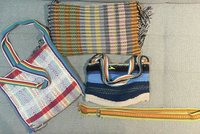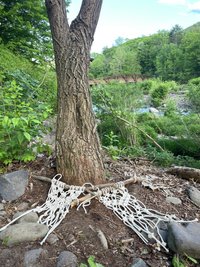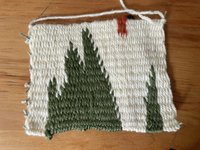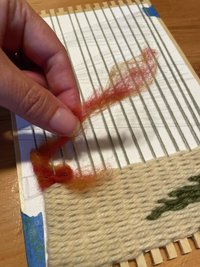Finding Resonance Amongst Diverse Cultures Through Weaving

The Weaving Connections: Finding Resonance Amongst Diverse Cultures project celebrates the cultural richness of Sunset Park’s communities by creating space for shared healing, creativity, and connection at the RISE UP Family Enrichment Center.
Based on the demographics of the Sunset Park community, the population is primarily composed of Asian and Latino residents. Many bring with them deep cultural traditions, rich histories, and resilient strategies for navigating life’s challenges. While they may carry the weight of past and ongoing hardships, they also embody profound creativity, wisdom, and strength. Sunset Park is home to a vibrant and diverse population living side by side—yet often remaining disconnected. Although systemic factors contribute to these divisions, these communities also hold powerful practices of care, resistance, and cultural expression that can be shared and celebrated across lines of difference.
When people feel seen, connected, and rooted in their cultures, they thrive. This work is about creating opportunities for cultural exchange and community building—where participants can celebrate and sustain their heritage while building relationships across communities and their own. The Family Enrichment Center’s mission includes bridging these groups, not through language alone, but through shared, lived experiences and creative practices like weaving. Rhythm, color, and tactile engagement offer ways of connecting that transcend words—inviting interdependence, understanding, and healing.

Through symbolic materials and storytelling, individuals will externalize their experiences and explore how their cultural identities can be sources of strength. Weaving becomes a way to honor the past while weaving into the present—helping participants feel more whole within themselves, their families, and more connected to others around them.
This project not only nurtures individual healing but also strengthens community bonds. While participants begin with individual weavings, the work will culminate in a collaborative piece to be installed in a public space—an offering to the community and a visible testament to shared resilience. In this way, healing becomes reciprocal: as participants find grounding and meaning through their own creativity, they contribute to a larger collective story.
Weaving is a deeply accessible practice that crosses barriers of language, age, and background. It is calming, organizing, and empowering—and it invites connection across cultures.

Sara and Family Enrichment Center team strongly believe in a community-led therapeutic approaches. We will guide participants to identify themes important to them to manifest in their weavings and in their process.
Sara and the FEC intend to involve participants in deciding how the projects will be implemented. Projects may be conducted in a workshop format if necessary, but will likely consist of weekly group sessions divided into class modules to ensure consistency, which is crucial for developmental growth, trust, and community building.
The Family Enrichment Center (FEC) is a warm, welcoming space co-designed with the community to feel like home—one that honors and celebrates the rich cultural identities of Sunset Park’s diverse residents. Grounded in values of dignity and mutual care, the FEC provides services, programs, and resources that promote both individual and collective wellbeing. At its core, the center seeks to build connection, resilience, and shared capacity by partnering with local residents and leaders to uplift community strengths and co-create programming that supports family wellness. Designed to be inclusive across racial, cultural, and economic backgrounds, the FEC fosters equity, cultural exchange, and creative expression.
Within this space, community traditions are honored as sources of strength. Practices like weaving play a central role in helping participants build relationships, express themselves, and root in a shared sense of purpose.

The looms used will mirror traditional techniques found in Latin America and around the world. The fiber arts processes are integrative and reparative. The thin belt looms are especially fun for children, rewarding, and helpful for those with attention deficits. Creating patterns is akin to coding, supporting mathematical development. Box looms or frame looms can be used to create pillows, bags, or hangings that can be linear or abstract. Felting, an integrative fiber technique, can also be used to create new pieces from wool roving. Sara hopes to hire weavers indigenous to the Sunset Park communities to share their expertise in weaving. Regardless of the method, integrating left and right brain functions and body movements through weaving can help repair trauma and build resilience. Engaging in this activity together fosters a sense of belonging and shared community.
The method of introducing projects is modeled after a multicultural developmental continuum of human growth, attachment, and belonging. From a Western (modern) perspective, the individual grows from the self outward. In many indigenous cultures, developmentally, family comes first. At the FEC, participants will begin exploring weaving either as individuals or in small groups, as they are currently living quite separately. Projects will familiarize them with different processes and invite them to contribute their own knowledge and creativity. These projects will provide opportunities for visual instruction and hand-over-hand support among participants. Group cohesion will build over time, non-verbally, transitioning from self and family to the community at large, thereby increasing the sense of belonging. Participants will collectively begin to populate the space with their creations, which may also be displayed in local venues and sold, aiding in economic mobility.
The project will culminate in the creation of a shared installation. For this installation, the group will choose a vision and materials, and the space will be selected in cooperation with community representatives who support the center in an ongoing manner.
